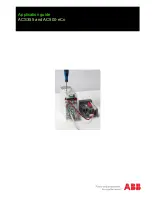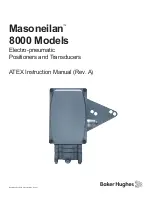
Page 1
INTRODUCTION
The differential pressure transmitter is designed with dual remote
sensors that enable it to accept high pressure in ranges up to 5
PSI to 500 PSI. All models can handle overload pressure 2X the
maximum fully scale range and burst pressure is 5X the maximum
full scale range.
Features include field selectable pressure ranges and output signal
types, output reversal and slow damping, port swapping and
bidirectional measurements for the most flexible applications. The
output signal is factory calibrated and temperature compensated
for the highest start-up accuracy.
WARNING : Ensure that the maximum individual port pressure
does not exceed the highest pressure range of the unit. For
example, the highest individual port pressure on a 102 Range
Code is 100 PSI. Exceeding this may damage the sensors and
give erroneous readings. See Figure 12 for ratings.
BEFORE INSTALLATION
Read these instructions carefully before installing and
commissioning the dewpoint transmitter. Failure to follow
these instructions may result in product damage. Do not use
in an explosive or hazardous environment, with combustible
or flammable gases, as a safety or emergency stop device or in
any other application where failure of the product could result
in personal injury.
Take electrostatic discharge precautions
during installation and do not exceed the device ratings
.
MOUNTING
The transmitter mounts on a vertical surface using the two integrated mounting holes. The remote
sensor cable connection should be located on the bottom of the enclosure. The two mounting holes will
facilitate a #10 size screw (not supplied). See Figure 1. Ensure
there is enough space around the unit to make the electrical
connections and that it is within an acceptable distance for
the length of remote sensor cables. Avoid locations with
severe vibrations or excessive moisture. The enclosure has a
standard opening for a conduit connector or cable gland type
fitting. In this position the High port is on the left and the Low
port is on the right as shown on the PCB.
The enclosure has a hinged cover with a latch. Open the
cover by pulling slightly on the latch on the bottom side of
the enclosure and at the same time pulling on the cover, as
illustrated in Figure 2.
A 1/2" NPT threaded connection hole is provided in the left
side of the enclosure as shown in Figure 3. Screw the EMT
connector or cable gland connector in until tight. See Figure 4.
It is recommended that weatherproof conduit or cable gland
fittings be used. The F style enclosure includes 1/2" NPT to
M16 thread adapter and cable gland fitting.
Two security screws are provided which can be installed to
help secure the cover once settings and wiring connections
are complete. See Figure 4.
Conduit
Figure 1
Figure 2
Figure 4
Figure 3
Figure 5
EMT Connector
Thread adapter and
cable gland fitting
IN-GE-DPXXX-02-02 11/19
Copyright © Greystone Energy Systems, Inc. All Rights Reserved Phone: +1 506 853 3057 Web: www.greystoneenergy.com
Differential Pressure Transmitter
DP Series - Installation Instructions























